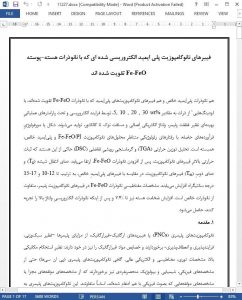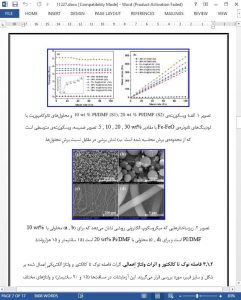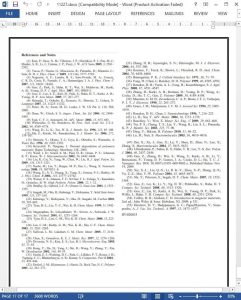Both pure polyimide (PI) and Fe-FeO nanoparticles reinforced PI nanocomposite fibers with a particle loading of 5, 10, 20, and 30 wt % are produced by electrospinning with optimized operational parameters such as polymer concentration, applied electrical voltage, and tip-to-collector distance. The morphology of the resulting products is correlated to the corresponding rheological behaviors of the pure PI and Fe-FeO/PI nanocomposite solutions. Thermogravimetric analysis (TGA) and differential scanning calorimetry (DSC) reveal an enhanced thermal stability of the nanocomposite fibers after introducing the Fe-FeO nanoparticles. The glass transition temperature (Tg) and melting temperature (Tm) of the nanocomposite fibers increase by 10−12 and 15−17 °C, respectively, as compared to those of the pure PI fibers. The magnetic properties of the Fe-FeO nanoparticles in the polymer nanocomposite fibers are different from those of the as-received nanoparticles. An increased shell thickness by 7.4% is deduced after the nanoparticles experiencing the high-voltage electrospinning.
1. Introduction
Polymer nanocomposites (PNCs) or organic-inorganic hybrids attain the advantages of the polymers such as light weight, easy processability, and flexibility, and introduce the propensity of the inorganic materials such as high mechanical strength and excellent electrical, magnetic, and optical properties. Sometimes, PNCs even possess unique physical, chemical, or biological properties, which are essentially different from those of the components taken separately or physically combined properties of each component. These PNCs have attracted wide interest in both academic and industrial fields for their diverse potential applications in energy storage devices,1 electronics,2,3 microwave absorbers,4,5 and sensors.6
4. Conclusion
Pure PI and Fe@FeO/PI nanocomposites fibers are produced by electrospinning. The effects of polymer concentration, acceleration voltage, and tip-to-collector distance on the morphology and size distribution of the fibers are systematically studied. Higher voltage is required for the fabrication of nanocomposite fibers at high nanoparticle loadings owning to the increased viscosity of the nanocomposite solutions. TGA and DSC results indicate an enhanced thermal stability with an increased glass transition (Tg) temperature of the nanocomposite fibers as compared to that of the pure PI fibers. The nanoparticles in the nanocomposites fibers become magnetically harder with a significant increase of coercivity from 62.3 Oe (as-received Fe@FeO nanoparticles) to 188.2 Oe. Meanwhile, an increase of about 7.4% in the nanoparticle shell thickness is deduced during the high-voltage electrospinning fiber fabrication process.











